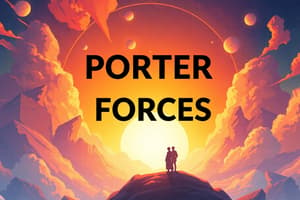Podcast
Questions and Answers
What is the primary purpose of a successful strategy?
What is the primary purpose of a successful strategy?
- To align with current market trends
- To create competitive advantage and generate superior financial returns (correct)
- To reduce operational costs
- To adopt modern marketing techniques
Which of the following statements about strategy is true?
Which of the following statements about strategy is true?
- Strategy is synonymous with cost-cutting measures.
- Strategy is primarily about product innovation.
- Operational effectiveness is essential for strategy but not sufficient on its own. (correct)
- Effective strategy focuses only on short-term gains.
What does Michael Porter’s Five Forces Framework primarily evaluate?
What does Michael Porter’s Five Forces Framework primarily evaluate?
- Factors affecting individual company performance
- Structural factors influencing industry profitability (correct)
- Consumer behavior in highly competitive markets
- Operational efficiency within a firm
Which of the following is NOT a misconception about strategy?
Which of the following is NOT a misconception about strategy?
What significant economic change contributed to the application of strategy in business during the 19th century?
What significant economic change contributed to the application of strategy in business during the 19th century?
Which analysis, developed in the 1960s, supported the need for a strategic overarching plan?
Which analysis, developed in the 1960s, supported the need for a strategic overarching plan?
What is a common reason industries have varying levels of profitability according to classic economic theories?
What is a common reason industries have varying levels of profitability according to classic economic theories?
Which of the following factors does Porter’s framework systematically evaluate?
Which of the following factors does Porter’s framework systematically evaluate?
What is the main focus of the Blue Ocean Strategy?
What is the main focus of the Blue Ocean Strategy?
In the Resource-Based View (RBV), what are considered the primary components that contribute to a company’s advantage?
In the Resource-Based View (RBV), what are considered the primary components that contribute to a company’s advantage?
How does an emergent strategy differ from a deliberate strategy?
How does an emergent strategy differ from a deliberate strategy?
Which of the following represents a key takeaway regarding competitive advantage?
Which of the following represents a key takeaway regarding competitive advantage?
What defines an industry in a business context?
What defines an industry in a business context?
Which factor is NOT considered to determine the value of resources in the Resource-Based View?
Which factor is NOT considered to determine the value of resources in the Resource-Based View?
What outcome might occur if a firm operates in a red ocean strategy?
What outcome might occur if a firm operates in a red ocean strategy?
What can enhance the power of complements in a market?
What can enhance the power of complements in a market?
Which company exemplifies the concept of an emergent strategy by successfully pivoting its business model?
Which company exemplifies the concept of an emergent strategy by successfully pivoting its business model?
How does the Premier League influence demand for other services?
How does the Premier League influence demand for other services?
What is a key factor in determining the influence of complements on an industry?
What is a key factor in determining the influence of complements on an industry?
What does successful positioning in a market segment involve?
What does successful positioning in a market segment involve?
How can firms reshape industry structures over time?
How can firms reshape industry structures over time?
What is one way companies can profit in highly competitive environments?
What is one way companies can profit in highly competitive environments?
What role do switching costs play in market dynamics?
What role do switching costs play in market dynamics?
What can mitigate rivalry from competitors in a market?
What can mitigate rivalry from competitors in a market?
Flashcards
Blue Ocean Strategy
Blue Ocean Strategy
Creating new market demand by offering a differentiated value proposition that no existing company has yet delivered, often entering new or shifting the boundaries of existing industries.
Red Ocean
Red Ocean
Existing markets where competition is intense, growth is slow, and profit margins are squeezed.
Resource-Based View (RBV)
Resource-Based View (RBV)
A strategic approach emphasizing a company's internal resources and capabilities as sources of competitive advantage.
Emergent Strategy
Emergent Strategy
Signup and view all the flashcards
Industry
Industry
Signup and view all the flashcards
Competitive Advantage
Competitive Advantage
Signup and view all the flashcards
Sustainable Advantage
Sustainable Advantage
Signup and view all the flashcards
Industry Analysis
Industry Analysis
Signup and view all the flashcards
What is strategy?
What is strategy?
Signup and view all the flashcards
What are the two requirements to achieve competitive advantage?
What are the two requirements to achieve competitive advantage?
Signup and view all the flashcards
Why is alignment important for strategy?
Why is alignment important for strategy?
Signup and view all the flashcards
What is NOT strategy?
What is NOT strategy?
Signup and view all the flashcards
What is operational effectiveness?
What is operational effectiveness?
Signup and view all the flashcards
What are the two main drivers of strategy evolution?
What are the two main drivers of strategy evolution?
Signup and view all the flashcards
What is the main premise of SWOT analysis?
What is the main premise of SWOT analysis?
Signup and view all the flashcards
What did Porter's Five Forces framework shift focus to?
What did Porter's Five Forces framework shift focus to?
Signup and view all the flashcards
Relative Switching Costs
Relative Switching Costs
Signup and view all the flashcards
Influence on Demand
Influence on Demand
Signup and view all the flashcards
Asymmetric Threats
Asymmetric Threats
Signup and view all the flashcards
Rate of Profit Growth
Rate of Profit Growth
Signup and view all the flashcards
Positioning in Industry Analysis
Positioning in Industry Analysis
Signup and view all the flashcards
Reshaping Industry Structures
Reshaping Industry Structures
Signup and view all the flashcards
Profitability in Tough Industries
Profitability in Tough Industries
Signup and view all the flashcards
Key Considerations in Industry Analysis
Key Considerations in Industry Analysis
Signup and view all the flashcards
Study Notes
Introduction to Strategy
- Strategy is about deciding where to compete (industries/markets) and how to compete (firm's position/activities).
- Effective strategy aligns activities for consistent, sustainable financial returns.
- Misconceptions surround strategy—it's not just marketing, innovation, or cost-cutting; it's about competitive positioning.
Evolution of Competitive Strategy
- Strategy's roots are in military strategies, focusing on broad goals (not tactics).
- 19th-century businesses adopted strategic thinking.
- Key industrial advances (e.g., better access to capital, economies of scale) drove the development of business strategy.
Porter's Five Forces Framework
- A framework to analyze industry attractiveness, developed in 1979.
- It assesses industry profitability by evaluating five forces:
- Threat of new entrants: Ease of entry; barriers (capital, brand loyalty).
- Bargaining power of suppliers: Supplier concentration; buyer/supplier switching costs.
- Bargaining power of buyers: Buyer concentration; substitutes available.
- Threat of substitutes: Availability of alternatives.
- Intensity of rivalry: Number of competitors; industry growth rate.
Complementary Forces
- Later addition by Brandenburger and Nalebuff complementing goods/services that enhance a product's value.
- Complements influence product value and switching costs.
- Examples of complementary forces include apps on app stores or tools and services that support construction firms.
Business Models
- A company's underlying logic, operations, and value capture.
- Components include:
- Value propositions: Differentiation/low cost.
- Target market: Broad/narrow.
- The goal is to maximize willingness-to-pay (WTP) minus costs.
Industry Analysis
- Analyses how profits are distributed among market participants and helps firms adapt.
- Helps identify threats, opportunities, and strategic actions.
- Key steps include: defining the industry; identifying players; analyzing their influence; testing and refining; developing strategies.
- The Five Forces Framework analyzes competitive forces shaping industry profitability.
Strategic Considerations
- Strategic positioning involves crafting a unique position in the market relative to competitors to fend off competitive threats.
- Diversify products and brands to mitigate rivalry and strengthen the market position.
- Key elements are profitability in tough industries; identifying new positions; recognizing and exploiting change; actively shaping industry structure to advantage; leveraging technology; expanding into new markets.
Creating Attractive Environments
- Businesses can reshape industry structures.
- Creating buyer loyalty and reducing seller reliance will decrease buyer power.
- A deeper understanding of the industry's forces allows companies to identify attractive positions and strategies.
Competitiveness and Advantage
- Competitiveness is measured by the difference between customer's willingness-to-pay and suppliers' costs.
- Strategies aim to increase the gap between these, leading to stronger advantage.
- Value creation means a firm's unique contribution to a transaction, making it more valuable to customers and suppliers. Strategies must align with value creation principles.
Network Effects
- Externalities arise when market participants affect others without compensation.
- Networks (digital & physical) become more valuable as more people join.
- Positive feedback cycles arise when added users increase value.
- Collective switching costs discourage users from switching.
Evolution Strategy vs. Revolution Strategy
- Evolution: maintains compatibility with existing technologies; smooths user migration.
- Revolution: emphasizes high performance even at the cost of incompatibility; attracts new users.
Studying That Suits You
Use AI to generate personalized quizzes and flashcards to suit your learning preferences.




